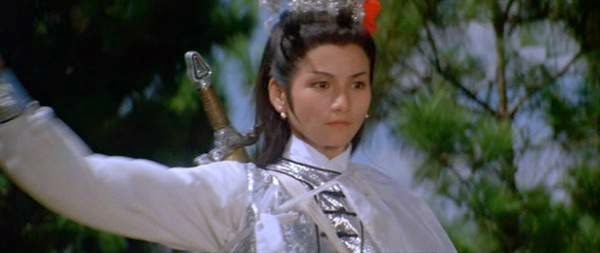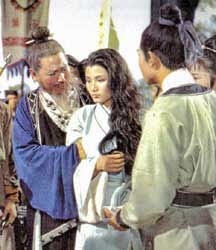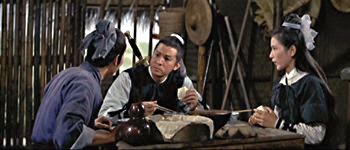Kevin Crawford, author of Spears of the Dawn, Stars Without Number and Scarlet Heroes, was kind enough to let me interview him. Here is what he had to say:
![]() |
| Scarlet Heroes cover by Eric Lofgren |
BD: You have worked on of Old School RPGs, including Spears of the Dawn and Stars Without Number. What does OSR mean to you and why are you drawn to that type of design?
KC: I consider myself an "OSR publisher" in a purely pragmatic sense. It's a label that conveys a clear message to my audience: "If you get this thing, you can use it with a lot of things you already have." While a lot of other great games have come along over the years, literally millions of people know how to play an old version of D&D. Even people who don't especially care for it can understand the mechanics well enough to translate them into their own preferred system. It's the closest thing the hobby has to a lingua franca.
I find this useful because my games aren't normally about mechanical innovation, barring exceptions like Scarlet Heroes. I'm not really trying to find a better way to fight an orc or swing from a chandelier. Instead, my games are about providing the GM and players with the right framework for accomplishing certain things- sandbox sci-fi, or free-roaming post-apocalyptic play, or African-flavored classic adventuring, or whatever else the book is trying to do. For that, I need a solid, reliable game system that can be understood and remixed easily by my readers. Old-school mechanics work perfectly for that.
BD: Your current project is Scarlet Heroes, can you tell us a little bit about it?
KC: For Scarlet Heroes, the premise is simple. It's a game meant for a GM and just one or two players, for those times when you can't get a full group together or want to introduce a particular friend or family member to the hobby. It allows you to use existing old-school adventures and content, and you can even run your own favorite OSR games using Scarlet Heroes' system to allow for lone adventurers with a halfway-decent chance of survival. Aside from the mechanical core, it also includes a self-contained write-up of my Red Tide campaign setting, sixty adventure tags for building your own content, and a sheaf of resources for running the game in GM-less solo adventure mode.
BD: What is the Red Tide Setting and how does it relate to Scarlet Heroes?
KC: The Red Tide campaign setting is one I built several years ago to support a campaign that eventually ran from D&D 3.5 to 4th edition. I had a huge number of players for it, and players being who they are, they wanted a wide variety of concepts. As a consequence, I had to build a setting that could support that kind of variety. The result was the Red Tide world.
In a nutshell, it's a post-apocalyptic fantasy world where the nations of the world were forced to flee for refuge to a remote archipelago of islands. The remnants of dozens of different nations now find themselves pressed together, fighting the local Shou tribes for land and survival, while others seek to explore yet-untouched islands in the chain and find the resources and room the exiles need to live. The main island is balkanized into several major city-states, some of whom are almost in a state of war, while others are hard-pressed by the Shou and their own troubles. It's been three hundred years since the exiles first arrived in the Isles and the first flush of panicked cooperation is now starting to break down into mutual suspicion and hostilities. Worse still, the apocalypse that devoured the rest of the world is now starting to extend its tendrils to the Isles, and the exiles have no better idea how to deal with it now than they did then. The PCs are heroes in this land, there to either make things better for a suffering domain or make things much more enjoyable for themselves.
BD: What were you major sources of inspiration while working on Scarlet Heroes?
KC: Classic pulp sword & sorcery. The PCs of Scarlet Heroes are really mini-Conans even at first level. The idea is that they should be capable of the same feats and deal with the same dangers that we see pulp S&S protagonists handle even early on in their development. Evil wizards, jeweled temptresses, inordinate drinking, and the swift loss of large amounts of plunder all needed to play a role in the game.
BD: Scarlet Heroes is designed for the solo-adventure, with one player and one GM; how is it different from other attempts at this in the past? How did you approach it from a design stand-point?
KC: The chief difference is that Scarlet Heroes is seamlessly compatible with your existing old-school material. You don't need to rewrite adventures, or change stats, or even rework a character's sheet. The only thing that changes is how you read and use the numbers. The most important core mechanic is how damage dice are read.
In Scarlet Heroes, when you roll a damage die, you add whatever bonuses would normally apply and then compare the results to a scale. On a 1, you do no damage. On a 2-5, you do one point. On a 6-9, you do two points, and on a 10+, you do four points. Heroes subtract this damage from their hit points. Everyone else subtracts it _from their hit dice_. If a PC does enough damage to kill a target, they can spend the rest of it on any other victim in reach that their attack roll would've hit. In addition, every hero gets a "Fray die" which they can use once per round, even if they use their action to do something else. The Fray die represents their casual blows, passing strokes, minor zots of arcane force, or other heroic fisticuffs. Fighters get 1d8, clerics and thieves get 1d6, and magic-users get 1d4. This Fray die always does damage, but the injury it does can only be applied to monsters of equal or fewer hit dice than the hero's level, save that magic-users can zot foes of any level.
As a example, you can grab a generic 1st level fighter from your OSR game of choice. He's got 13 Strength, a 1d8 sword, 7 hit points, and he's fighting a pack of six 1 HD orcs. In most OSR games, that fighter's probably going to get chopped to kibble in short order. With Scarlet Heroes, however, things work differently.
First, he's a hero, so he always wins initiative. He rolls his Fray die and gets a 4, for one point of damage. He applies it against an orc, who dies automatically from the mighty backhand of a gauntleted fist. He then rolls an attack, hitting and rolling a modified 7 on his damage die, doing two points of damage and butchering another two hit dice worth of orcs. The panicked orcs then stab him three times, rolling 1, 4, an 6 for their damage rolls. Lights out for the hero? No, because those rolls end up doing zero, one, and two points of damage, leaving the fighter with 4 hit points left. Another round of butchery and the one remaining orc vainly attempts to flee before being brought down by the Fray die's representation of a hurled knife. The fighter then uses Scarlet Heroes' first aid rule to bind up two hit points of his wounds and soldiers on with 6 hit points remaining, ready to deal with the other perils of the adventure.
BD: In your opinion what is the biggest challenge to solo play?
KC: The speed of play. With a conventional table of four PCs, a GM has time to catch their breath. Even simple decisions usually need a few seconds of conversation among the players, and choices have a certain kind of momentum. The tacit dynamics discourage sudden and drastic changes of focus, and even players who aren't entirely sold on a course of action will usually play along with the majority of the group. These factors add up to a certain amount of warning and prep time for the GM even while the game is underway.
It doesn't work that way with a single player. There's no need for conferring with other players and no tacit social contract to go in a particular direction. If they want to do something, they can just do it, and they usually do. Single-PC gaming moves _fast_ compared to a group, and a GM needs to be properly supported by the system if they're going to be able to cope with that. They need a simple, familiar system, game content they're comfortable with, and enough structure that they can build out ad-hoc content when the player takes one of their inevitable zags into the unknown.
BD: Were there any surprises in playtesting?
KC: Not really, no. It's one of the main advantages of sticking with such a battle-tested game system. Even in the places where it's 'broken', people have had plenty of time to decide whether they can deal with those bits or not. Any weird edge-case situations were discovered thirty years ago and argued to death online during the Clinton administration.
The only fine-tuning that was needed was with the damage die scaling, which I originally had at 0/1/2 progression. I added the 4-point damage result when it turned out that two-handed weapon fighters and huge monsters needed more teeth.
BD: Scarlet Heroes is meant to be a stand-alone game but can also work with other OSR systems. How easy is it to fit mechanics of Scarlet Heroes to other old school games?
KC: It's trivially simple. Just use your game system of choice, but read the damage dice the Scarlet Heroes way. You can optionally bring aboard the Scarlet Heroes saving throw rolls and trait checks if you like. And as usual with my books, the adventure-creation and resource sections of the book are system-neutral and can be used regardless of the game you're running.
BD: What are Traits in Scarlet Heroes?
KC: A replacement for skills and class proficiencies. Each one is simply a label chosen by the player- "Former Mine Slave", "Unnaturally Persuasive", "Many Tong Friends", with a rating of 1 to 3. Whenever you try to do something that someone with that trait would be good at, you roll 2d8 and add your Trait and the most relevant ability modifier. If you beat the task's difficulty, you succeed, and if roll under, then things somehow go wrong or get complicated- because heroes do not normally just flatly fail at a task.
Traits take the place of racial and class proficiencies. Are halflings sneaky? They've got Halfling Stealth: 1. Are dwarves good at coping underground? They've got Dwarven Senses: 1. Is your hero a thief with a specialty in tomb plundering? She's got Tomb Raider: 3. Traits normally run only to a maximum of 3, but the special ability of the thief class is their ability to exceed this limit. A high-level thief who focuses their advancement exclusively on their specialty can eventually start throwing such huge bonuses at it that only magical opposition has any chance of slowing them down.
BD: In what other ways does Scarlet Heroes stand apart from standard OSR game systems?
KC: The adventure tags, really. People who've played my Stars Without Number or Other Dust games have seen the idea before. You have a set of basic trope labels, such as "Corrupt Magistrates" or "Buried Treasure", each providing a list of friends, enemies, places, things, and complications that fit that trope. You then pick two, grab some components out of them, and synthesize them together- so you have a corrupt local judge who's also digging for the treasure of a man he unjustly had executed, and his victim's vengeful daughter is looking for help to uncover his malfeasance.
The GMless gaming section is also a novelty in OSR games. It's a set of oracles, tables, and procedures to let a lone player take their hero through urban, dungeon, or wilderness adventures, generating events and using the oracles and their own choices to answer questions about the specifics.
BD: You did a Kickstarter for Scarlet Heroes, and it exceeded the funding goal by a considerable amount; why do you think it received such a positive response?
KC: Two factors were most important, I suspect. First, I have a very large audience willing to listen to me. At the time, I had more than sixteen thousand people willing to take my email on DTRPG's mailing list, and this number has doubled since then. People know what kind of material they're going to get when they buy Sine Nomine books. They're going to get OSR content involving a lot of system-neutral GM helps and campaign material, with an emphasis on sandbox gaming and easy content prep. A lot of people want that and they're willing to drop ten bucks to get immediate access to a PDF.
The second factor was a proven track record of delivery. My first Kickstarter for Spears of the Dawn delivered a month early. With Scarlet Heroes, I had print copies shipping less than a month after the Kickstart ended. The goal of my Kickstarters is to deliver a product, and that means getting the project straight before I go to the public for money. I spend a very large amount of time and effort on my Kickstart project management, and I don't pull the trigger on the campaign until everything is already checked out and in motion.
BD: Now that the Kickstarter for Scarlet Heroes has been successfully funded, what can people expect now?
KC: I've relaxed since then with a pair of smaller works, both for Stars Without Number: Dead Names gives a GM tools for building vanished or decayed alien races, with their ruins and enigmatic artifacts, and Engines of Babylon is a gear supplement with rules for vehicle construction and slower-than-light starships. But now it's time to turn to bigger projects, so I'm trying to finish up Silent Legions for an autumn Kickstarter.
Silent Legions is a modern Lovecraftian sandbox horror game that's fully compatible with Stars Without Number. The twist to Silent Legions is that it's Lovecraftian, but it doesn't involve the classic Mythos monsters and gods. Instead, it provides the GM with the tools and frameworks for creating their own Mythos. They build their own gods, cults, sorcerers, nefarious artifacts, and hideous monsters. Cthulhu's great, but there are already plenty of books that have handled him, and there's no reason to put out another. Instead, a GM can build their own homebrew abominations and restore a certain sense of mystery to an investigation.
Aside from the homebrew Mythos aspects, it's also built to support sandbox-style horror gaming. Instead of the classic premise of a sequence of adventures doled out to the PCs, the GM creates a region, seeds it with points of horrific interest, attaches hooks to them, and then unleashes the PCs on the setting. They choose the places that interest them, and the GM uses the tools in the book to expand the basic seeds into full horror adventures during the downtime between sessions. The GM advances plots and events as the campaign progresses, and the ultimate fate of the area is up to the heroes and their choices.
Needless to say, these tools need a lot of polish and tuning before they're going to be ready for public release, but I'm still hope to get it all written in time to Kickstart it in October or November.
--------------------
To learn more about Scarlet Heroes visit the
Sine Nomine Publishing website.


























































%2Bcopy.jpg)



